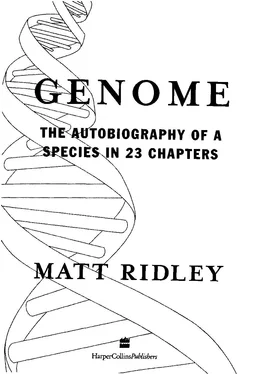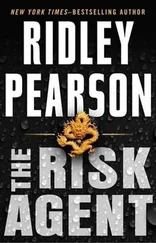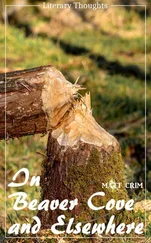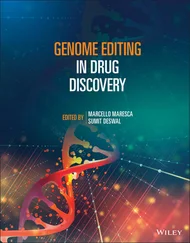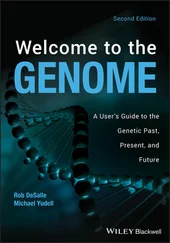Genome - Matt Ridley
Здесь есть возможность читать онлайн «Genome - Matt Ridley» — ознакомительный отрывок электронной книги совершенно бесплатно, а после прочтения отрывка купить полную версию. В некоторых случаях можно слушать аудио, скачать через торрент в формате fb2 и присутствует краткое содержание. Жанр: Старинная литература, на английском языке. Описание произведения, (предисловие) а так же отзывы посетителей доступны на портале библиотеки ЛибКат.
- Название:Matt Ridley
- Автор:
- Жанр:
- Год:неизвестен
- ISBN:нет данных
- Рейтинг книги:5 / 5. Голосов: 1
-
Избранное:Добавить в избранное
- Отзывы:
-
Ваша оценка:
- 100
- 1
- 2
- 3
- 4
- 5
Matt Ridley: краткое содержание, описание и аннотация
Предлагаем к чтению аннотацию, описание, краткое содержание или предисловие (зависит от того, что написал сам автор книги «Matt Ridley»). Если вы не нашли необходимую информацию о книге — напишите в комментариях, мы постараемся отыскать её.
Matt Ridley — читать онлайн ознакомительный отрывок
Ниже представлен текст книги, разбитый по страницам. Система сохранения места последней прочитанной страницы, позволяет с удобством читать онлайн бесплатно книгу «Matt Ridley», без необходимости каждый раз заново искать на чём Вы остановились. Поставьте закладку, и сможете в любой момент перейти на страницу, на которой закончили чтение.
Интервал:
Закладка:
But this is where things get interesting. If blood groups are invisible and neutral, then how did they evolve to the present state? Was it pure chance that landed the inhabitants of the Americas with type O blood? At first glance the blood groups seem to be an example of the neutral theory of evolution, promulgated by Motoo Kimura in 1968: the notion that most genetic diversity is there because it makes no difference, not because it has been picked by natural selection for a purpose. Kimura's theory was that mutation pumps a continual stream of mutations that do not affect anything into the gene pool, and that they are gradually purged again by genetic drift
- random change. So there is constant turnover without adaptive significance. Return to earth in a million years and large chunks of the human genome would read differently for entirely neutral reasons.
'Neutralists' and 'selectionists' for a while grew quite exercised about their respective beliefs, and when the dust settled Kimura was left with a respectable following. Much variation does indeed seem to be neutral in its effects. In particular, the closer scientists look at how proteins change, the more they conclude that most changes do not affect the 'active site' where the protein does its chemical tricks. In one protein, there have been 250 genetic changes since the Cambrian age between one group of creatures and another, yet only six of them matter at all.3
But we now know the blood groups are not as neutral as they seem. There is indeed a reason behind them. From the early 1960s, 1 4 0 G E N O M E
it gradually became apparent that there was a connection between blood groups and diarrhoea. Children with type A blood fell victim to certain strains of infant diarrhoea but not to others; children with type B blood fell victim to other strains; and so on. In the late 1980s, people with the O group were discovered to be much more susceptible to infection with cholera. Dozens of studies later, the details grow more distinct. Not only are those people with type O
blood susceptible, but those with A, B and AB differ in their susceptibility. The most resistant people are those with the AB
genotype, followed by A, followed by B. All of these are much more resistant than those with O. So powerful is this resistance in AB
people that they are virtually immune to cholera. It would be irresponsible to say that people with type AB blood can safely drink from a Calcutta sewer — they might get another disease - but it is true that even if these people did pick up the Vibrio bacterium that causes cholera and it settled in their gut, they would not get diarrhoea.
Nobody yet knows how the AB genotype offers protection against this most virulent and lethal of human diseases, but it presents natural selection with an immediate and fascinating problem.
Remember that we each have two copies of each chromosome, so A people are actually AAs, that is they have an A gene on each of their ninth chromosomes, and B people are actually BBs. Now imagine a population with just these three kinds of blood groups: A A , BB and A B . The A gene is better for cholera resistance than the B gene. AA people are therefore likely to have more surviving children than BB people. Therefore the B gene is likely to die out
- that's natural selection. But it doesn't happen like that, because AB people survive best of all. So the healthiest children will be the offspring of A A s and BBs. All their children will be A B , the most cholera-resistant type. But even if an AB mates with another A B , only half their children will be A B ; the rest will be AA and B B , the latter being the most susceptible type. It is a world of strangely fluctuating fortunes. The very combination that is most beneficial in your generation guarantees you some susceptible children.
D I S E A S E 1 4 1
Now imagine what happens if everybody in one town is A A , but a newcomer arrives who is B B . If she can fend off the cholera long enough to breed, she will have AB children, who will be resistant.
In other words, the advantage will always lie with the rare version of the gene, so neither version can become extinct because if it becomes rare, it comes back into fashion. This is known, in the trade, as frequency-dependent selection, and it seems to be one of the commonest reasons that we are all so genetically diverse.
This explains the balance between A and B. But if O blood makes you more susceptible to cholera, then why has natural selection not driven the O mutation extinct? The answer probably lies with a different disease, malaria. People with type O blood seem to be slightly more resistant to malaria than people of other blood groups.
They also seem to be slightly less likely to get cancers of various kinds. This enhanced survival was probably enough to keep the O
version of the gene from disappearing, despite its association with susceptibility to cholera. A rough balance was struck between the three variations on the blood group gene.
The link between disease and mutations was first noticed in the late 1940s by an Oxford graduate student with a Kenyan background, Anthony Allison. He suspected that the frequency of a disease called sickle-cell anaemia in Africa might be connected with the prevalence of malaria. The sickle-cell mutation, which causes blood cells to collapse in the absence of oxygen, is frequently fatal to those with two copies of it, but only mildly harmful to those with just one copy. But those with one copy are largely resistant to malaria. Allison tested the blood of Africans living in malarial areas and found that those with the mutation were far less likely to have the malaria parasite as well. The sickle-cell mutation is especially common in parts of west Africa where malaria has long been endemic, and is common also in African-Americans, some of whose ancestors came from west Africa in the slave ships. Sickle-cell disease is a high price paid today for malaria resistance in the past. Other forms of anaemia, such as the thalassaemia common in various parts of the Mediterranean and south-east Asia, appear to have a similar protective effect 1 4 2 G E N O M E
against malaria, accounting for its presence in regions once infested with the disease.
The haemoglobin gene, where the sickle-cell mutation occurs as just a single-letter change, is not alone in this respect. According to one scientist, it is the tip of an iceberg of genetic resistance to malaria. Up to twelve different genes may vary in their ability to confer resistance to malaria. Nor is malaria alone. At least two genes vary in their ability to confer resistance to tuberculosis, including the gene for the vitamin D receptor, which is also associated with a variability in susceptibility to osteoporosis. 'Naturally', writes Adrian Hill of Oxford University,4 'We can't resist suggesting that natural selection for TB resistance in the recent past may have increased the prevalence of susceptibility genes for osteoporosis.'
Meanwhile, a newly discovered but similar connection links the genetic disease cystic fibrosis with the infectious disease typhoid.
The version of the C F T R gene on chromosome 7 that causes cystic fibrosis — a dangerous disease of the lungs and intestines — protects the body against typhoid, an intestinal disease caused by a Salmonella bacterium. People with just one such version do not get cystic fibrosis, but they are almost immune to the debilitating dysentery and fever caused by typhoid. Typhoid needs the usual version of the C F T R gene to get into the cells it infects; the altered version, missing three D N A letters, is no good to it. By killing those with other versions of the gene, typhoid put natural pressure on the altered version to spread. But because people inheriting two copies of the altered version were lucky to survive at all, the gene could never be very common. Once again, a rare and nasty version of a gene was maintained by disease.5
Читать дальшеИнтервал:
Закладка:
Похожие книги на «Matt Ridley»
Представляем Вашему вниманию похожие книги на «Matt Ridley» списком для выбора. Мы отобрали схожую по названию и смыслу литературу в надежде предоставить читателям больше вариантов отыскать новые, интересные, ещё непрочитанные произведения.
Обсуждение, отзывы о книге «Matt Ridley» и просто собственные мнения читателей. Оставьте ваши комментарии, напишите, что Вы думаете о произведении, его смысле или главных героях. Укажите что конкретно понравилось, а что нет, и почему Вы так считаете.
